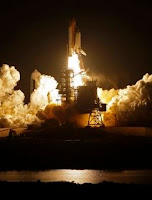On Retiring the Space Shuttle
NASA brought the Space Shuttle program to an end this July after more than 30 years of service to the nation and to cause of space exploration. Since I continue to hear the occasional complaint from one person or another about why NASA brought this program to an end, I thought I would write this post so I easily link to it later when I might need it.
The Space Shuttle was a terrific vehicle for taking us into Earth's orbit. It enabled us to launch and repair satellites and to build the International Space Station. Those were fantastic missions, but they're done. It's time for NASA to move onto the next level of exploring space. Unfortunately, the Space Shuttle simply isn't the right vehicle for our next steps in space exploration.
As an example, former Presidents George H. W. Bush, Bill Clinton, and George W. Bush, as well as President Barack Obama, all endorsed the long-term goal of a manned mission to Mars during each of the respective tenures in the White House. It's time for NASA to start preparing for such a mission.
The problem, of course, is that the Space Shuttle needs a runway in order to land and there are no runways currently on Mars. Without such a runway, the Space Shuttle could only circle around the planet. It could never land astronauts on the planet's surface.
 |
| The Surface of Mars, Without A Runway In Sight |
The same holds true for NASA's plans for a manned mission to land on an asteroid as well as the possible return to the Moon for additional long-term scientific research. None of these places have a runway. Therefore, the Space Shuttle couldn't land there.
Since the Space Shuttle can't land anywhere that doesn't have something like a runway, and NASA's next steps in the voyage of discovery are all to places without runways, the unavoidable conclusion is that the Shuttle simply isn't the right vehicle for what comes next in human discovery.
There are, of course, those who argue that NASA should have kept the Space Shuttle going until its next vehicle is ready. Once upon a time, I would've argued the same thing. However, one of the things that NASA has learned the hard way is that it's exceedingly difficult to build the next thing while one is still doing the old thing. This is particularly true when the next thing is something as big and complex as exploring space.
The fact of the matter is that NASA has made more progress towards designing and building the Space Shuttle's replacement in the past two years, when the end of the Shuttle was announced, then they did in the five years prior to that. It is simply better for an agency like NASA to put all of its resources towards preparing for the next thing, rather than try to juggle old and new technologies.
The timing for all of this has also never been better. There are now private companies that are on the verge of launching commercial ventures into space. They can take care of launching new satellites and servicing old ones, which is a task previously done by the Space Shuttle.
For anything that the private sector isn't currently equipped to handle, the Europeans, Chinese, and Russians can take care of it. They are doing today the sorts of things that NASA was doing thirty years ago and they will continue to do them. It's time for NASA to continue its leadership in space by moving onto the next thing.
It's time for NASA to land a spacecraft on an asteroid; to launch a manned expedition to Mars and to return to the Moon. These are the challenges that await NASA. They will be met, not with the Space Shuttle, but with our next generation of spacecraft. I, for one, eagerly look forward to what is next for America's space program.





Comments